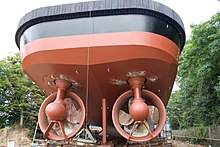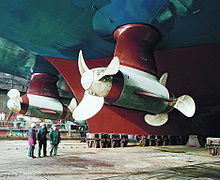Propeller pod
Propeller gondola (also called pod drive or azi-pod ) is the name of a drive unit for watercraft and aircraft .
shipping
The drive is covered with a streamlined gondola and rotates 360 degrees around the vertical axis. The propeller is attached to the front of the nacelle as a pull propeller , as a jacketed pusher propeller to the rear of the nacelle or in a combination of one or more free-running pull and push propellers. The drive in the form of an electric motor can also be located in the nacelle.
The "classic" propeller gondola is the Schottel rudder propeller (Schottel drive) , a pusher propeller encased by a Kort nozzle , which can be rotated 360 ° around the vertical axis, especially under the hull of ferries and tugs. It is driven by the motor in the fuselage via shafts and angular gear.
The propeller nacelle is technically a consistent further development of the conventional Schottel drive , but without affecting Schottel's property rights and patent rights. In addition, in a Schottel drive, the thrust propeller is built into a Kort nozzle , while in propeller nacelles the propellers rotate freely without a protective ring which influences the hydrodynamics .
History and manufacturer
The principle of pod drives was invented and patented as a further development of the active rudder as a further development of the active rudder as early as 1955 by FW Pleuger and Friedrich Busmann (company Pleuger Unterwasserpumpen GmbH, Hamburg - today Pleuger Industries GmbH, Hamburg) (including patent 2714866, United States Patent. Office, August 1955 ). At that time, however, they were too far ahead of their time. The pioneers in the development of today's propeller nacelles were Schottel and Wärtsilä in commercial propulsion and Volvo Penta in leisure boating.
There are around six well-known manufacturers of pod drives worldwide. These include the Swedish-Swiss ABB with the Azipod , the British Rolls-Royce plc with their Mermaid Pods or the large German corporation Siemens in cooperation with the Schottel shipyard located in Spay near Koblenz , which has owned the SSP ( Siemens-Schottel -Propulsion ) develop, produce and market (this drive has an output of up to 20 megawatts and is therefore in the upper performance class). Volvo-Penta calls its propeller pod system IPS and Brunswick / Mercury calls it Zeus .
As described above, the engine manufacturers and shipyards gave their respective system of propeller pods their own name, often with brand and property rights .
Systems

Propeller pods can be driven purely mechanically or electrically. In the purely mechanical variant, there is a diesel engine in the hull, which acts on the propeller shaft in the nacelle via a mechanical transmission.
The electrical variant also has mechanical transmission from an electrical drive motor in the hull or the electrical motor integrated in the nacelle with direct coupling of the propeller shaft. In both cases, the electrical energy is usually generated by a diesel engine with a downstream generator . The position of the diesel and generator unit is independent of the position of the propeller pod.
Propeller pods can be equipped with either one or two propellers. In the case of the nacelles with two propellers, there are two systems: either with two propellers running in the same direction (tandem) or with counter-rotating propellers (counter-rotating). Due to the opposite direction of rotation, the propeller twist is used by the rear propeller to increase the efficiency. Propeller pods with only one propeller can be designed as a pull propeller (the propeller is located at the front of the nacelle) or as a pusher propeller (the propeller is located at the rear of the nacelle).
Ships with gondolas that can be swiveled through 360 ° generally do not need any oars , as the gondolas connect the drive and the maneuvering organ. The precise setting of the propeller jet means that at low ship speeds, e.g. B. when mooring or holding position, given a very good maneuverability of the ship. Due to the lack of rudders, on the other hand, course stability is lower.
When choosing an electric drive, the position of the propeller pods can in principle be freely selected. For practical reasons, it is still classic at the stern, since here the maximum leverage for maneuvering is guaranteed. Some deep-sea tugs also have propeller gondolas that can be swiveled out in the floor of the foredeck. The resistance is a bit cheaper, as no attachments such as waves and wave brackets influence the wake of the ship. On the other hand, due to their size, the nacelles themselves are negative, so that the manufacturers invest a great deal of effort in keeping them small or in improving the flow around them with the help of small profiles .
The common name Pod comes from the brand name POD of the company Wärtsilä , which is considered to be the "inventor" of this system.
Even if the technology seems simple, it is complex and requires certain minimum hull sizes. This led to different solutions in the recreational boating industry. There, as with the Schottel drive, the drive power is brought into the nacelle via shafts and gears from the motor in the fuselage through the slewing ring. In contrast to the Schottel system, in recreational boating there is no thrust propeller rotating in a Kort nozzle on a propeller gondola , but two free counter-rotating traction propellers. This system has been available for commercial shipping as well as for pleasure craft since 2005 ; however, for the latter it cannot be rotated 360 degrees around the vertical axis, but only around the circular sector necessary for maneuvering a pleasure craft .
In theory, the compact solutions used by recreational shipping also allow the propeller pods to be rotated 360 degrees around the vertical axis. In practice, chimneys are frowned upon on pleasure craft and exhaust gases are led to the outside through the drives (here, the propeller pods). The gas tightness required in the exhaust system, however, limits the rotatability of the propeller gondolas common in recreational boating to a segment of a circle.
Both in commercial shipping and in leisure shipping there are always at least two propeller gondolas on the watercraft, as only then do the advantages over classic wave systems come into their own so that they make up for the high purchase price.
Advantages and disadvantages
Compared to conventional shaft systems, propeller pods have the following advantages:
- In conjunction with a diesel-electric drive, driving profiles with a high proportion of low and partial loads may result in lower fuel consumption.
- The smallest turning circles can be achieved, especially in the area of low ship speeds.
- The integration into the ship is usually uncomplicated, since all components of the drive come from one manufacturer and only have to be installed at the shipyard. In conventional systems, different manufacturers are usually responsible for each component.
- The stop times and distances are extremely short, since the gondolas are only turned and the motors do not have to be reversed.
- Avoidance of possible vibrations on the propeller, which can arise from the drive shaft.
However, the propeller pods also have some disadvantages:
- The design efficiency is usually worse than with a conventional propeller-shaft-motor system, since either high gear or high conversion losses occur.
- The mass is much larger than with conventional systems.
- The costs are also much higher than with a conventional system.
- The maximum available propeller diameter and thus achievable drive power are lower than with conventional drives.
Applications
Many of the best-known and largest cruise ships have a pod drive, such as the Queen Mary 2 (entered service in 2004), the Freedom of the Seas (2006), Allure of the Seas (2010), as well as the largest cruise ship by 2018 World, the Harmony of the Seas (2016).
The Ostfriesland ferry operated by Reederei AG Ems has had two pod drives since its conversion - it was lengthened by 15.3 meters and received a new "dual fuel" engine (for LNG and diesel).
The German ice edge research ship Maria S. Merian , which was put into service in 2005, has two pod drives that enable very good dynamic positioning for scientific work.
The pod drive is also used to break ice . To do this, the propeller points in the direction of the ice and when reversing, the water flow breaks away pieces of ice. One example is the Mastera , an oil tanker with a high ice class .
The system is also used on larger warships, such as landing ships like the Spanish Juan Carlos I (L-61) or helicopter carriers like the ships of the French Mistral class .
aviation
In aviation, propeller nacelles are mainly known for airships . Here, gondolas that can be swiveled around a horizontal axis and are attached to both sides of the passenger cabin are used not only as drives, but also for height control, especially at low forward speeds when the effect of the rudder surfaces is reduced, or in order to save personnel during take-offs and landings. In many historical airships, the motors in the propeller pods could also be operated and serviced in the air.
The tilt rotor used in convertible aircraft is based on a similar system , the axis of rotation of which can be swiveled between the vertical and horizontal position in order to convert the “helicopter” into an “airplane” (and vice versa) during flight, thus ensuring good take-off and maneuvering properties of a helicopter with the economy of a fixed wing aircraft . (Examples: Bell-Agusta BA609 , Bell V-22 and Bell Eagle Eye ).
LZ 126 shows three of its five propeller pods here
rotating propeller nacelle, tiltrotor, on the Bell Boeing V-22 Osprey
See also
literature
Ludwig Dürr : Twenty-five years of Zeppelin airship construction. (1924), Chapter III. Development of the Z-ships according to shape, size and performance. Section: nacelle arrangement. u. a. as reprint in The Great Zeppelins - The History of Airship Construction. Peter Kleinheins, Wolfgang Meighörner (eds.); 3rd edition, Springer-Verlag, 2005, ISBN 3-540-21170-5 .
Web links
Individual evidence
- ↑ Henning Sietz: Stump ahead, Spitz follows, towards the North Sea - the transfer of the "Norwegian Gem". In: FAZ No. 223, September 25, 2007, p. T1.
- ↑ Imprint - Pleuger Industries. Retrieved February 26, 2019 .
- ↑ Company information on Azipods , abb.de
- ↑ Company information on Mermaid Pods , rolls-royce.com
- ^ Company information on the Siemens-Schottel Propulsor , industry.siemens.com
- ↑ Deutsche Maritime Shipping July / August 2015, pp. 24–31
- ↑ EU supports the construction of the new Heligoland ferry ( Memento from July 21, 2015 in the Internet Archive )






